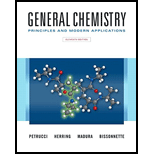
EBK GENERAL CHEMISTRY
11th Edition
ISBN: 9780133400588
Author: Bissonnette
Publisher: VST
expand_more
expand_more
format_list_bulleted
Concept explainers
Question
Chapter 25, Problem 52E
Interpretation Introduction
Interpretation:
The conditions under which
Concept introduction:
The most stable isotope of radon is said to be 222Rn.
The amount of time taken by any substance to lose half of its initial value is known as half-life and the half-life value for 222Rn is 3.82 days.
Any substance that could cause any type of harm to the environment is a hazardous substance.
Expert Solution & Answer
Want to see the full answer?
Check out a sample textbook solution
Students have asked these similar questions
Provide the missing information. *see image
I have a bottle of butanal that has been improperly used by lab workers. They allowed a traceamount NaOH (aq) to contaminate the bottle. What is now in my bottle of “butanal? What is the molecular name and functional group name? Draw the structure.
Provide the missing information. *see image
Chapter 25 Solutions
EBK GENERAL CHEMISTRY
Ch. 25 - Prob. 1ECh. 25 - Prob. 2ECh. 25 - Prob. 3ECh. 25 - Prob. 4ECh. 25 - Prob. 5ECh. 25 - Prob. 6ECh. 25 - Prob. 7ECh. 25 - Prob. 8ECh. 25 - Prob. 9ECh. 25 - Prob. 10E
Ch. 25 - Prob. 11ECh. 25 - Prob. 12ECh. 25 - Prob. 13ECh. 25 - Prob. 14ECh. 25 - Prob. 15ECh. 25 - Prob. 16ECh. 25 - Prob. 17ECh. 25 - Prob. 18ECh. 25 - Prob. 19ECh. 25 - Prob. 20ECh. 25 - Prob. 21ECh. 25 - Prob. 22ECh. 25 - Prob. 23ECh. 25 - Prob. 24ECh. 25 - Prob. 25ECh. 25 - Prob. 26ECh. 25 - Prob. 27ECh. 25 - Prob. 28ECh. 25 - Prob. 29ECh. 25 - Prob. 30ECh. 25 - Prob. 31ECh. 25 - Prob. 32ECh. 25 - Prob. 33ECh. 25 - Prob. 34ECh. 25 - Prob. 35ECh. 25 - Prob. 36ECh. 25 - Prob. 37ECh. 25 - Prob. 38ECh. 25 - Prob. 39ECh. 25 - Prob. 40ECh. 25 - Prob. 41ECh. 25 - Prob. 42ECh. 25 - Prob. 43ECh. 25 - Prob. 44ECh. 25 - Prob. 45ECh. 25 - Prob. 46ECh. 25 - Prob. 47ECh. 25 - Prob. 48ECh. 25 - Prob. 49ECh. 25 - Prob. 50ECh. 25 - Prob. 51ECh. 25 - Prob. 52ECh. 25 - Prob. 53ECh. 25 - Prob. 54ECh. 25 - Prob. 55ECh. 25 - Prob. 56ECh. 25 - Prob. 57IAECh. 25 - Prob. 58IAECh. 25 - Prob. 59IAECh. 25 - Prob. 60IAECh. 25 - Prob. 61IAECh. 25 - Prob. 62IAECh. 25 - Prob. 63IAECh. 25 - Prob. 64IAECh. 25 - Prob. 65IAECh. 25 - Prob. 66IAECh. 25 - Prob. 67IAECh. 25 - Prob. 68IAECh. 25 - Prob. 69IAECh. 25 - Prob. 70IAECh. 25 - Prob. 71IAECh. 25 - Prob. 72FPCh. 25 - Prob. 73FPCh. 25 - Radioactive decay and mass spectrometry are often...Ch. 25 - Prob. 75SAECh. 25 - Prob. 76SAECh. 25 - Prob. 77SAECh. 25 - Prob. 78SAECh. 25 - Prob. 79SAECh. 25 - Prob. 80SAECh. 25 - Prob. 81SAECh. 25 - Prob. 82SAECh. 25 - Prob. 83SAECh. 25 - Prob. 84SAECh. 25 - Prob. 85SAECh. 25 - Prob. 86SAECh. 25 - Prob. 87SAECh. 25 - Prob. 88SAECh. 25 - Prob. 89SAECh. 25 - Prob. 90SAECh. 25 - Prob. 91SAECh. 25 - Prob. 92SAECh. 25 - Prob. 93SAE
Knowledge Booster
Learn more about
Need a deep-dive on the concept behind this application? Look no further. Learn more about this topic, chemistry and related others by exploring similar questions and additional content below.Similar questions
- First image: Why can't the molecule C be formed in those conditions Second image: Synthesis for lactone C its not an examarrow_forwardFirst image: I have to show the mecanism for the reaction on the left, where the alcohol A is added fast in one portion Second image: I have to show the mecanism of the reaction at the bottom. Also I have to show by mecanism why the reaction wouldn't work if the alcohol was primaryarrow_forwardFirst image: I have to explain why the molecule C is never formed in those conditions. Second image: I have to propose a synthesis for the lactone Aarrow_forward
- 20.44 The Diels-Alder reaction is not limited to making six-membered rings with only car- bon atoms. Predict the products of the following reactions that produce rings with atoms other than carbon in them. OCCH OCCH H (b) CH C(CH₂)s COOCH མ་ནས་བ (c) N=C H -0.X- (e) H C=N COOCHS + CH2=CHCH₂ →→arrow_forwardGiven the attached data, provide the drawing for the corresponding structure.arrow_forwardno Ai walkthroughsarrow_forward
arrow_back_ios
SEE MORE QUESTIONS
arrow_forward_ios
Recommended textbooks for you
 Chemistry: The Molecular ScienceChemistryISBN:9781285199047Author:John W. Moore, Conrad L. StanitskiPublisher:Cengage Learning
Chemistry: The Molecular ScienceChemistryISBN:9781285199047Author:John W. Moore, Conrad L. StanitskiPublisher:Cengage Learning Chemistry: Principles and ReactionsChemistryISBN:9781305079373Author:William L. Masterton, Cecile N. HurleyPublisher:Cengage Learning
Chemistry: Principles and ReactionsChemistryISBN:9781305079373Author:William L. Masterton, Cecile N. HurleyPublisher:Cengage Learning Chemistry by OpenStax (2015-05-04)ChemistryISBN:9781938168390Author:Klaus Theopold, Richard H Langley, Paul Flowers, William R. Robinson, Mark BlaserPublisher:OpenStax
Chemistry by OpenStax (2015-05-04)ChemistryISBN:9781938168390Author:Klaus Theopold, Richard H Langley, Paul Flowers, William R. Robinson, Mark BlaserPublisher:OpenStax Chemistry & Chemical ReactivityChemistryISBN:9781337399074Author:John C. Kotz, Paul M. Treichel, John Townsend, David TreichelPublisher:Cengage Learning
Chemistry & Chemical ReactivityChemistryISBN:9781337399074Author:John C. Kotz, Paul M. Treichel, John Townsend, David TreichelPublisher:Cengage Learning Chemistry & Chemical ReactivityChemistryISBN:9781133949640Author:John C. Kotz, Paul M. Treichel, John Townsend, David TreichelPublisher:Cengage Learning
Chemistry & Chemical ReactivityChemistryISBN:9781133949640Author:John C. Kotz, Paul M. Treichel, John Townsend, David TreichelPublisher:Cengage Learning

Chemistry: The Molecular Science
Chemistry
ISBN:9781285199047
Author:John W. Moore, Conrad L. Stanitski
Publisher:Cengage Learning

Chemistry: Principles and Reactions
Chemistry
ISBN:9781305079373
Author:William L. Masterton, Cecile N. Hurley
Publisher:Cengage Learning

Chemistry by OpenStax (2015-05-04)
Chemistry
ISBN:9781938168390
Author:Klaus Theopold, Richard H Langley, Paul Flowers, William R. Robinson, Mark Blaser
Publisher:OpenStax

Chemistry & Chemical Reactivity
Chemistry
ISBN:9781337399074
Author:John C. Kotz, Paul M. Treichel, John Townsend, David Treichel
Publisher:Cengage Learning

Chemistry & Chemical Reactivity
Chemistry
ISBN:9781133949640
Author:John C. Kotz, Paul M. Treichel, John Townsend, David Treichel
Publisher:Cengage Learning
